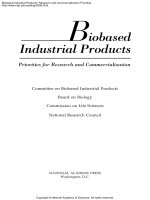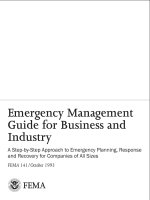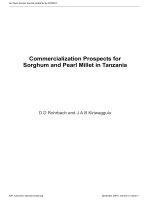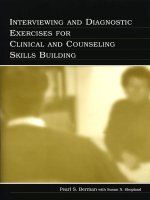- Trang chủ >>
- Đại cương >>
- Kinh tế vĩ mô
electrical course for apprentices and journeymen
Bạn đang xem bản rút gọn của tài liệu. Xem và tải ngay bản đầy đủ của tài liệu tại đây (4.73 MB, 424 trang )
Audel
™
Electrical Course for
Apprentices and
Journeymen
All New Fourth Edition
Paul Rosenberg
PQ793-1046G-PFM[i-xviii].qxd 2/20/04 2:39 AM Page iii Quark05 Quark05:BOOKS:PQ JOBS:PQ793:FINAL:
PQ793-1046G-PFM[i-xviii].qxd 2/20/04 2:39 AM Page ii Quark05 Quark05:BOOKS:PQ JOBS:PQ793:FINAL:
Audel
™
Electrical Course for
Apprentices and
Journeymen
All New Fourth Edition
PQ793-1046G-PFM[i-xviii].qxd 2/20/04 2:39 AM Page i Quark05 Quark05:BOOKS:PQ JOBS:PQ793:FINAL:
PQ793-1046G-PFM[i-xviii].qxd 2/20/04 2:39 AM Page ii Quark05 Quark05:BOOKS:PQ JOBS:PQ793:FINAL:
Audel
™
Electrical Course for
Apprentices and
Journeymen
All New Fourth Edition
Paul Rosenberg
PQ793-1046G-PFM[i-xviii].qxd 2/20/04 2:39 AM Page iii Quark05 Quark05:BOOKS:PQ JOBS:PQ793:FINAL:
Vice President and Executive Group Publisher: Richard Swadley
Vice President and Executive Publisher: Robert Ipsen
Vice President and Publisher: Joseph B. Wikert
Executive Editorial Director: Mary Bednarek
Editorial Manager: Kathryn A. Malm
Executive Editor: Carol A. Long
Senior Production Editor: Fred Bernardi
Development Editor: Regina Brooks
Production Editor: Pamela Hanley
Text Design & Composition: Wiley Composition Services
Copyright © 2004 by Wiley Publishing, Inc. All rights reserved.
Copyright © 1974 by Howard W. Sams & Co., Inc.
Copyright © 1984 by G.K. Hall & Co., Inc.
Copyright © 1988 by Macmillan Publishing Company, a division of Macmillan, Inc.
Published simultaneously in Canada
No part of this publication may be reproduced, stored in a retrieval system, or
transmitted in any form or by any means, electronic, mechanical, photocopying,
recording, scanning, or otherwise, except as permitted under Section 107 or 108 of
the 1976 United States Copyright Act, without either the prior written permission
of the Publisher, or authorization through payment of the appropriate per-copy fee
to the Copyright Clearance Center, Inc., 222 Rosewood Drive, Danvers, MA
01923, (978) 750-8400, fax (978) 646-8700. Requests to the Publisher for permis-
sion should be addressed to the Legal Department, Wiley Publishing, Inc., 10475
Crosspoint Blvd., Indianapolis, IN 46256, (317) 572-3447, fax (317) 572-4447,
E-mail:
Limit of Liability/Disclaimer of Warranty: While the publisher and author have used
their best efforts in preparing this book, they make no representations or warranties
with respect to the accuracy or completeness of the contents of this book and specifi-
cally disclaim any implied warranties of merchantability or fitness for a particular pur-
pose. No warranty may be created or extended by sales representatives or written sales
materials. The advice and strategies contained herein may not be suitable for your situ-
ation. You should consult with a professional where appropriate. Neither the publisher
nor author shall be liable for any loss of profit or any other commercial damages,
including but not limited to special, incidental, consequential, or other damages.
For general information on our other products and services please contact our
Customer Care Department within the United States at (800) 762-2974, outside the
United States at (317) 572-3993 or fax (317) 572-4002.
Trademarks: Wiley, the Wiley Publishing logo, Audel, and related trade dress are
trademarks or registered trademarks of John Wiley & Sons, Inc. and/or its affiliates in
the United States and other countries and may not be used without written permission.
All other trademarks are the property of their respective owners. Wiley Publishing,
Inc. is not associated with any product or vendor mentioned in this book.
Wiley also publishes its books in a variety of electronic formats. Some content that
appears in print may not be available in electronic books.
Library of Congress Cataloging-in-Publication Data:
ISBN: 0-764-54200-1
Printed in the United States of America
10987654321
PQ793-1046G-PFM[i-xviii].qxd 2/20/04 2:39 AM Page iv Quark05 Quark05:BOOKS:PQ JOBS:PQ793:FINAL:
Contents
Introduction xiii
Chapter 1 Electricity and Matter 1
Elements, Atoms, Molecules,
and Compounds 1
Electron Theory 3
Electric Current 9
Insulators and Conductors 11
Questions 12
Chapter 2 Units and Definitions 13
Fundamental and Derived Units 13
Definitions 15
Magnetic Units 17
Temperature Units 18
Questions 18
Chapter 3 Electrical Symbols 21
Graphic Electrical Wiring Symbols 21
0.1 Drafting Practices Applicable to
Graphic Electrical Wiring Symbols 21
0.2 Explanation Supplementing the
Schedule of Symbols 23
List of Symbols 27
1.0 Lighting Outlets 27
2.0 Receptacle Outlets 28
3.0 Switch Outlets 31
4.0 Signaling System Outlets: Institutional,
Commercial, and Industrial
Occupancies 31
5.0 Signaling System Outlets: Residential
Occupancies 36
v
PQ793-1046G-PFM[i-xviii].qxd 2/20/04 2:39 AM Page v Quark05 Quark05:BOOKS:PQ JOBS:PQ793:FINAL:
vi Contents
6.0 Panelboards, Switchboards, and
Related Equipment 37
7.0 Bus Ducts and Wireways 38
8.0 Remote Control Stations for
Motors or Other Equipment* 39
9.0 Circuiting 39
10.0 Electric Distribution or Lighting
System, Underground 40
11.0 Electric Distribution or Lighting
System Aerial 41
Arrester, Lightning Arrester
(Electric Surge, etc.) Gap 42
Battery 43
Circuit Breakers 43
Circuit Return 45
Coil, Magnetic Blowout* 45
Contact, Electrical 46
Contactor 48
Machine, Rotating 49
Meter Instrument 53
Path, Transmission, Conductor,
Cable Wiring 55
Polarity Symbol 56
Switch 57
Transformer 58
Chapter 4 Magnets and Magnetic Fields 63
Magnetic Poles 63
Magnetic and Nonmagnetic
Substances 64
The Earth as Magnet 64
Magnetic Lines of Force 65
Molecular Theory of Magnetism 66
Strength of a Magnet 68
Lifting Power of a Magnet 68
Questions 69
PQ793-1046G-PFM[i-xviii].qxd 2/20/04 2:39 AM Page vi Quark05 Quark05:BOOKS:PQ JOBS:PQ793:FINAL:
Chapter 5 Ohm’s Law 71
Statement of Ohm’s Law 71
Analogy of Ohm’s Law 71
Illustrations of Ohm’s Law 72
Ohm’s Law and Power 74
The Ohm’s Law Circle 74
Formulas 75
Ohm’s Law 75
Power in Watts 75
Questions 76
Chapter 6 Capacitors 77
Capacitance 83
Capacitance in Series and Parallel 84
Capacitance in Other Than Regular
Capacitors 86
Formulas 87
Questions 87
Chapter 7 Resistance 89
Skin Effect 97
Conductivity 97
Voltage-Drop Calculation 99
Measuring Conductors 100
Questions 101
Chapter 8 Resistance in Series and Parallel 103
Resistances in Series 103
Resistances in Parallel 104
Series-Parallel Circuits 107
Questions 109
Chapter 9 Electrolysis 111
Terminology 111
Chemistry of Electrolysis 112
Contents vii
PQ793-1046G-PFM[i-xviii].qxd 2/20/04 2:39 AM Page vii Quark05 Quark05:BOOKS:PQ JOBS:PQ793:FINAL:
viii Contents
Electroplating 114
Corrosion 114
Questions 116
Chapter 10 Primary and Secondary Cells 117
The Voltaic Cell 117
Primary Cells 119
Secondary Cells 122
Questions 127
Chapter 11 Electromagnetism 129
Galvanoscope 134
Solenoids 135
Questions 136
Chapter 12 Laws Governing Magnetic Circuits 139
Strength of a Magnetic Pole 141
Intensity of Magnetizing Force 142
Magnetic Reluctance 142
Formulas 149
Questions 149
Chapter 13 Work, Power, Energy, Torque,
and Efficiency 151
Torque 155
Prony Brake 156
Formulas 158
Questions 158
Chapter 14 Instruments and Measurements 161
Voltmeters and Ammeters 163
Edison Pendulum Ammeter 163
Battery Gauge 164
Indicating Wattmeter 165
Ohmmeters 168
Thermostats 169
Thermocouples 169
Questions 170
PQ793-1046G-PFM[i-xviii].qxd 2/20/04 2:39 AM Page viii Quark05 Quark05:BOOKS:PQ JOBS:PQ793:FINAL
Chapter 15 Insulation Testing 171
Test Voltages vs. Equipment Ratings 172
Cables and Conductors 174
Conductors in Parallel 181
Effect of Temperature on Insulation
Resistance* 185
Questions 185
Chapter 16 Electromagnetic Induction 187
Basic Principles 187
Lenz's Law 188
Fleming's Rule 192
Mutual Induction 192
Eddy Currents 194
Questions 195
Chapter 17 Alternating Currents 197
Advantages of AC 197
Generation of AC 197
AC Sine Wave 201
Paralleling Alternators 203
Formulas 204
Questions 204
Chapter 18 DC Generators 207
Generators vs. Alternators 207
Generation of EMF 207
Armatures 208
Brushes 211
Types of Generators 212
Generator Voltage Control 214
Questions 214
Chapter 19 DC Motors 215
Armature Movement 215
DC Motors vs. DC Generators 215
Regulation of DC Motors 216
Starting the DC Motor 220
Contents ix
PQ793-1046G-PFM[i-xviii].qxd 2/20/04 2:39 AM Page ix Quark05 Quark05:BOOKS:PQ JOBS:PQ793:FINAL:
x Contents
Reversing Motor Direction 220
Questions 221
Chapter 20 Inductance and Reactance 223
Inductance 223
Inductive Reactance 223
Impedance 224
Effects of Circuit Inductance 225
Phase Angle 226
True Power and Power Factor 229
Worked Examples 230
Formulas 232
Questions 233
Chapter 21 Capacitance in AC Circuits 235
Analogy of Capacitor Action 235
Capacitor Action 236
Capacitance 236
Current and Voltage Relations 237
Capacitive Reactance 238
Inductive and Capacitive Circuits 238
Formulas 241
Questions 241
Chapter 22 Resistance, Capacitance,
and Inductance in Series and Parallel 243
RC Circuit 243
RLC Circuit 244
Parallel LC Circuit 248
Resonance 249
System Power Factor 251
Formulas 253
Questions 253
Chapter 23 Polyphase Circuits 255
Multiphase Systems 255
Two-Phase Systems 255
Three-Phase Systems 257
Questions 261
PQ793-1046G-PFM[i-xviii].qxd 2/20/04 2:39 AM Page x Quark05 Quark05:BOOKS:PQ JOBS:PQ793:FINAL:
Chapter 24 Power in Polyphase Circuits 263
Three-Phase Wye Connection 264
Three-Phase Delta Connection 266
Economy and Phases 268
Neutral Current in Three-Phase,
Four-Wire Systems 269
Formulas 273
Questions 274
Chapter 25 Transformer Principles 277
Induction Coil 277
Transformer Types 279
Principles of Operation 280
Windings and Voltages 281
Formulas 284
Questions 284
Chapter 26 Transformer Facts 285
Transformer Impedance 287
Transformers in Parallel 289
Transformer Insulation 289
Types of Transformers 290
Effects of Altitudes 290
Ambient Temperature 290
Transformer Polarity 291
Termination Marking 292
Formulas 293
Questions 294
Chapter 27 Transforming Polyphase Power 295
Single-Phase for Three-Phase 295
Three-Phase Transformers 297
Two-Phase to Three-Phase
Conversion 299
Delta- and Wye-Connection Voltages
and Currents 301
Questions 302
Contents xi
PQ793-1046G-PFM[i-xviii].qxd 2/20/04 2:39 AM Page xi Quark05 Quark05:BOOKS:PQ JOBS:PQ793:FINAL:
xii Contents
Chapter 28 Autotransformers 303
Autotransformers and Conventional
Transformers 303
Induction Voltage Regulator 304
Transformer Booster 305
Questions 306
Chapter 29 Instrument Transformers 307
Use of Instrument Transformers 307
Types of Instrument Transformers 307
Potential Transformers 308
Current Transformers 309
Ratings 309
Opening the Secondary Circuit 309
Symbols 310
Ground Fault Protection 310
Questions 312
Chapter 30 Polyphase Induction Motors 313
Rotating Magnetic Field 313
Squirrel Cage Rotor Winding 316
Wound Rotors 320
Dual Voltages 320
Induction Motors on Start 324
Altitude Correction 326
Power Factor 326
Questions 328
Chapter 31 Power-Factor Correction 329
Reactive Kilovolt-Amperes 329
Use of Correction Table 329
Correction with Capacitors 331
Use of Chart 331
Use of Mathematics 332
Overloads 335
Reasons for Corrections 335
Questions 336
PQ793-1046G-PFM[i-xviii].qxd 2/20/04 2:39 AM Page xii Quark05 Quark05:BOOKS:PQ JOBS:PQ793:FINAL:
Chapter 32 Synchronous Motors 337
Characteristics 337
Operation 337
Power Factor 339
Regulation 340
Questions 342
Chapter 33 Single-Phase Motors 343
Phase Splitting 343
Shading-Coil Motors 344
Universal Motors 345
Hysteresis Motors 345
Split-Phase Induction Motor 345
Capacitor-Start Motors 347
Capacitor-Start, Capacitor-Run Motor 347
Repulsion Motors 348
Repulsion-Induction Motors 350
Questions 351
Chapter 34 Grounding and Ground Testing 353
Grounding Requirements 353
Conduction in Soil 354
Grounding Electrode 356
Fall-of-Potential Method 356
System Grounding 362
Questions 366
Chapter 35 Rectifiers 367
Mercury-Arc Rectifier 367
Dry-Contact Rectifiers 368
Solid-State Rectifiers 370
Rectifier Connections 371
Questions 373
Chapter 36 Number of Bends in Conduit 375
Chapter 37 Torque Test for Bolts and Screws 381
Appendix 383
Index 391
Contents xiii
PQ793-1046G-PFM[i-xviii].qxd 2/20/04 2:39 AM Page xiii Quark05 Quark05:BOOKS:PQ JOBS:PQ793:FINAL:
PQ793-1046G-PFM[i-xviii].qxd 2/20/04 2:39 AM Page xiv Quark05 Quark05:BOOKS:PQ JOBS:PQ793:FINAL
xv
Introduction
An apprentice electrician prepares to become a journeyman typi-
cally during a four-year period. These four years include 2000
hours per year of on-the-job training, or a total of 8000 hours.
During off-hours an apprentice studies electrical theory, methods,
equipments, and the NEC.
My purpose in writing this book was to provide the apprentice
or journeyman with most of the information he or she is required to
know. I have drawn on my experience as a former instructor of
apprentice and journeymen electricians to include most of the vital
material on both electrical theory and its applications.
This book has been planned as a study course either for the
classroom or as a self-taught program. It may be utilized without
any other books on electrical theory.
Very little on the NEC is included since two other Audel books
offer abundant information on it. Guide to the National Electrical
Code, which is updated annually as the NEC is changed, gives a
very complete interpretation of the Code. Questions and Answer
for Electrician’s Examinations can further help the electrician
toward a thorough knowledge of the NEC.
Trigonometry is covered briefly in this book, because it is useful
in making mathematical calculations of alternating currents. For
the reader who is not familiar with trigonometry, there are other
means of explanation.
It is not the intent of this book to give a complete discussion of all
electrical subjects. However, with the basic information presented
here, the apprentice or journeyman can gain an understanding of
operational theory and progress even further, if he or she wishes.
I sincerely hope that this book will be of value to you, the elec-
trician. It has been my good fortune to learn a great deal from oth-
ers in our field, and I have presented here the information I have
gained. Any knowledge that you or future electricians gain from
this book will make my time spent in writing it worthwhile.
The basics of electricity really do not change, but the applica-
tions of these basics do change. Therefore, I hope that you will con-
tinue your studies throughout your career and keep abreast of the
continual changes in the field. You will find that in modern society
the person with the know-how is the person who advances.
A college degree is a valuable asset—get one if you can. But
remember that much of the information offered by a degree pro-
gram may be gained by self-study. Many people with technical
PQ793-1046G-PFM[i-xviii].qxd 2/20/04 2:39 AM Page xv Quark05 Quark05:BOOKS:PQ JOBS:PQ793:FINAL:
xvi Introduction
know-how are needed to back up the engineering profession, and a
technical education is receiving increased recognition.
I wish to extend my sincere thanks to the many fine people I’ve
worked with through the years. Your contributions have been critical.
Paul Rosenberg
PQ793-1046G-PFM[i-xviii].qxd 2/20/04 2:39 AM Page xvi Quark05 Quark05:BOOKS:PQ JOBS:PQ793:FINAL
Audel
™
Electrical Course for
Apprentices and
Journeymen
All New Fourth Edition
PQ793-1046G-PFM[i-xviii].qxd 2/20/04 2:39 AM Page xvii Quark05 Quark05:BOOKS:PQ JOBS:PQ793:FINAL
PQ793-1046G-PFM[i-xviii].qxd 2/20/04 2:39 AM Page xviii Quark05 Quark05:BOOKS:PQ JOBS:PQ793:FINAL
Chapter 1
Electricity and Matter
Electricity is one of the great wonder-workers of our modern
world. It is a force that powers thousands of inventions that make
life more pleasant. Electricity is a property of certain particles to
possess a force that can be used for the transmission of energy.
Whenever electricity is used, you may be assured that an equal
amount of some other form of energy was previously used to pro-
duce the electricity.
In order to gain an understanding of what electricity is, we must
go into some study of matter, molecules, atoms, and elements. This
is what may be termed the electron theory.
A Greek philosopher, Thales, in about 600 B.C., discovered
that a piece of amber rubbed with a woolen cloth would attract
pieces of chaff and other light objects, much as a magnet attracts
iron filings. The Greek word for amber is elektron and it probably
is from this word that the English words “electricity” and “elec-
tron” were derived. More on this phenomenon will be covered
later.
Elements, Atoms, Molecules, and Compounds
All substances may be termed matter, and matter may be liquid,
solid, or gaseous. A good example is water. Water may be a solid
(ice), a liquid (water) with which we wash or drink, and a gas or
steam (vapor), which we get when water is boiled. Whether it is ice,
liquid, or vapor, its chemical makeup does not change; only the
state in which it appears changes.
Elements are substances that can’t be changed, decomposed by
ordinary types of chemical change, or made by chemical union.
There are over 100 known elements, distinguishable by their
chemical and physical differences. Some common elements are
copper, silver, gold, oxygen, hydrogen, sulfur, zinc, lead, helium,
and uranium.
A molecule is the smallest unit quantity of matter that can exist
by itself and retain all the properties of the original substance. It
consists of one or more atoms.
Atoms are regarded as the smallest particles that retain the prop-
erties of the element and which, by chemical means, matter may be
divided into.
1
PQ793-1046G-P01[001-012].qxd 2/20/04 12:31 AM Page 1 Quark05 Quark05:BOOKS:PQ JOBS:PQ793:FIN
2 Chapter 1
Some of the more than 100 elements and their characteristics are
given in Table 1-1. From this table and the symbols for the elements
appearing in this table, it will be easier to gain insight concerning
compounds. Some everyday compounds are
Water (H
2
O): Two atoms of hydrogen and one atom of
oxygen.
Sulfuric acid (H
2
SO
4
): Two atoms of hydrogen, one atom of
sulfur, and four atoms of oxygen.
Salt (NaCl): One atom of sodium and one atom of chlorine.
Table 1-1 Elements and Their Characteristics
Atomic Atomic
Number Element Symbol Weight
13 Aluminum Al 26.98
51 Antimony Sb 121.76
18 Argon A or Ar 39.948
56 Barium Ba 137.34
4 Beryllium Be 9.01
83 Bismuth Bi 208.98
5 Boron B 10.81
48 Cadmium Cd 112.40
20 Calcium Ca 40.08
6 Carbon C 12.011
55 Cesium Cs 132.905
17 Chlorine Cl 35.453
24 Chromium Cr 51.996
27 Cobalt Co 58.93
29 Copper Cu 63.54
9 Fluorine F 19.00
79 Gold Au 196.967
2 Helium He 4.003
1 Hydrogen H 1.008
26 Iron Fe 55.847
82 Lead Pb 207.21
3 Lithium Li 6.94
12 Magnesium Mg 24.32
25 Manganese Mn 54.94
80 Mercury Hg 200.61
(continued)
PQ793-1046G-P01[001-012].qxd 2/20/04 12:31 AM Page 2 Quark05 Quark05:BOOKS:PQ JOBS:PQ793:FIN
Table 1-1 (continued)
Atomic Atomic
Number Element Symbol Weight
42 Molybdenum Mo 95.94
10 Neon Ne 20.183
28 Nickel Ni 58.71
7 Nitrogen N 14.007
8 Oxygen O 16.000
15 Phosphorus P 30.974
78 Platinum Pt 195.09
19 Potassium K 39.102
88 Radium Ra 226.05
45 Rhodium Rh 102.91
34 Selenium Se 78.96
14 Silicon Si 28.09
47 Silver Ag 107.87
11 Sodium Na 22.991
38 Strontium Sr 87.62
16 Sulfur S 32.066
90 Thorium Th 232.038
50 Tin Sn 118.69
74 Tungsten W 183.85
92 Uranium U 238.03
30 Zinc Zn 65.37
Some forms of matter are merely mixtures of various elements
and compounds. Air is an example; it has oxygen, nitrogen, helium,
argon, neon, and some compounds such as carbon dioxide (CO
2
)
and carbon monoxide (CO).
One may wonder what all of this has to do with electricity, but
it is leading up to an explanation of the electron theory, which
follows.
Electron Theory
An atom may be roughly compared to a solar system in which a sun
is the nucleus around which orbit one or more planets, the number
of which depends on which atom we pick from the various ele-
ments. (Bear in mind that this is not a completely accurate descrip-
tion, as electrons seem to move in figure eights, rather than in
Electricity and Matter 3
PQ793-1046G-P01[001-012].qxd 2/20/04 12:31 AM Page 3 Quark05 Quark05:BOOKS:PQ JOBS:PQ793:FIN
4 Chapter 1
circles. Nonetheless, the comparison between a solar system and an
atom is useful.)
The nucleus is composed of protons and neutrons, and orbiting
around this nucleus of protons and neutrons are electrons. An elec-
tron is a very small negatively charged particle. Electrons appear to
be uniform in mass and charge and are one of the basic parts of
which an atom is composed. The charge of the electron is accepted
as 4.80 ϫ 10
–10
absolute electrostatic unit. This indicates that all
electrons are alike regardless of the element of which they are a
part.
A neutron is an elementary particle with approximately the mass
of a hydrogen atom but without an electrical charge.
A proton is an elementary particle having a positive charge
equivalent to the negative charge of an electron but possessing a
mass approximately 1845 times as great.
From Table 1-1, we find the atomic number (number of protons
in the nucleus) of hydrogen is 1, helium is 2, lithium is 3, beryllium
is 4, etc. Figure 1-1 shows the atoms of hydrogen, helium, lithium,
and beryllium, with the electrons orbiting around the nucleus of
neutrons and positively charged protons. Notice that the positive
charge of the protons in the nucleus equals the negative charge of
the electrons and holds them in orbit.
Electrons may be released from their atoms by various means.
Some atoms of certain elements release their electrons more readily
than atoms of other elements. If an atom has an equal number of
electrons and protons, it is said to be in balance. If an atom has
given up some of its electrons, the atom will then have a positive
charge, and the matter that received the electrons from the atom
will be negatively charged. Some external force must be used to
transfer the electrons.
Before progressing further, any electrical discussion must include
static electricity, for a better understanding of insulation and con-
ductors, as well as to carry on with the discussions of dislodging
electrons. The word “static” means at rest. There are some applica-
tions where static electricity is put to use, but in other cases it is
detrimental and must be avoided. We are faced with lightning,
which is static electricity discharges attempting to neutralize oppo-
site charges. Since we have to live with lightning’s harmful effects,
we should know how to cope with it. The methods of avoiding the
harmful effects of lightning are not fully discovered but much
progress has been made.
One method of dislodging electrons is by the friction of rubbing
a hard rubber rod with a piece of fur. The fur will give up some
PQ793-1046G-P01[001-012].qxd 2/20/04 12:31 AM Page 4 Quark05 Quark05:BOOKS:PQ JOBS:PQ793:FIN









